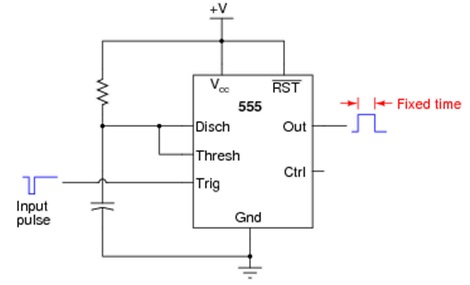 |
Monostable multivibrator often called a one shot multivibrator is a pulse generating circuit in which the duration of this pulse is determined by the RC network connected externally to the 555 timer. In a stable or standby state, the output of the circuit is approximately zero or a logic-low level. When external trigger pulse is applied output is forced to go high (>> VCC). The time for which output remains high is determined by the external RC network connected to the timer. At the end of the timing interval, the output automatically reverts back to its logic-low stable state. The output stays low until trigger pulse is again applied. Then the cycle repeats. The monostable circuit has only one stable state (output low) hence the name monostable.
Initially when the circuit is in the stable state i.e , when the output is low, transistor Q1 is ON and the capacitor C is shorted out to ground. Upon the application of a negative trigger pulse to pin 2, transistor Q1 is turned OFF, which releases the short circuit across the external capacitor C and drives the output high. The capacitor C now starts charging up towards VCC through R. When the voltage across the capacitor equals 2/3 VCC, comparator 1's output switches from low to high, which inturn drives the output to its low state via the output of the flip-flop. At the same time the output of the flip-flop turns transistor Q1 ON and hence the capacitor C rapidly discharges through the transistor. The output of the monostable remains low until a trigger pulse is again applied. Then the cycle repeats.
The pulse width of the trigger input must be smaller than the expected pulse width of the output waveform. Also the trigger pulse must be a negative going input signal with amplitude larger than 1/3 VCC.
The time during which the output remains high is given by :







